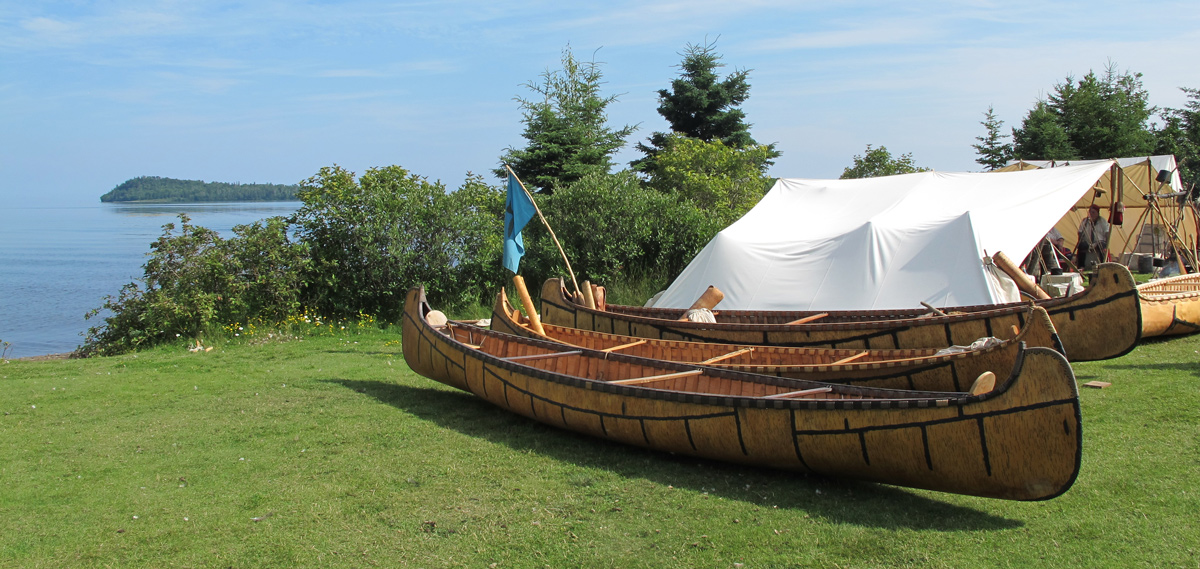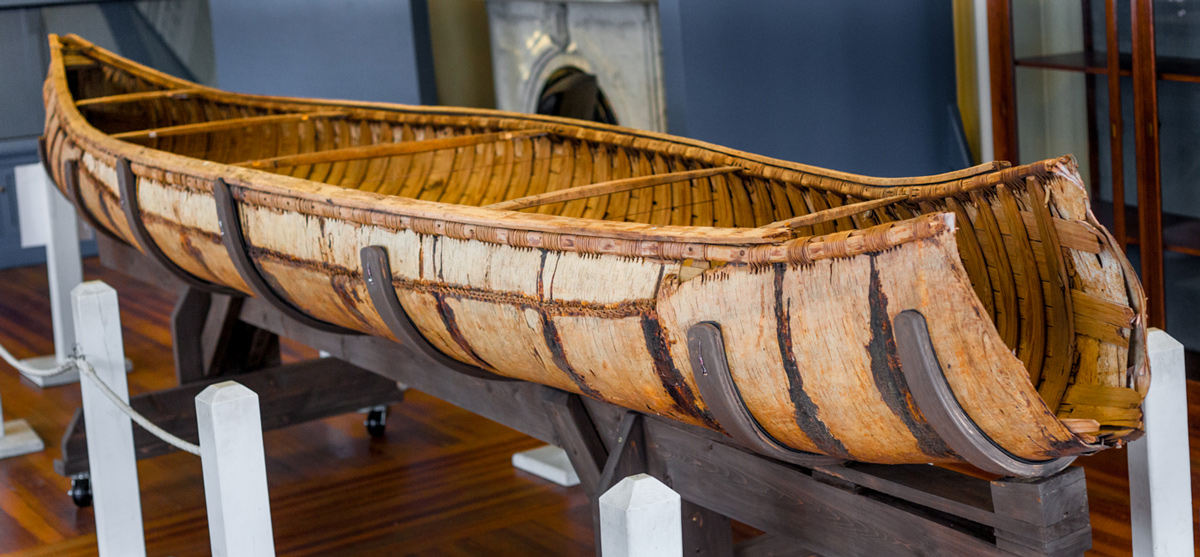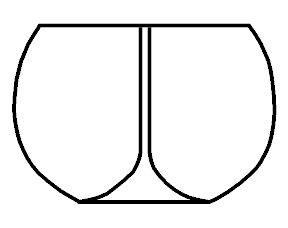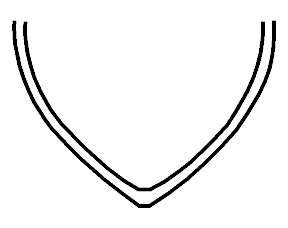The name Missouri River is said to have come from
the now-extinct tribe of Indians of the Siouan
linguistic family who were known as the Missouris, or
‘those who have dugout canoes.’
These canoes are north canoes used on the north shore of Lake Superior and into western Canada. They are about 24 feet long.—ed.
Chittenden’s Formula
I have suggested that the Lewis and Clark canoes were probably light. But “light” compared to what? Near Fort Clatsop, Clark described one of their canoes as “stout,” often quoted to support the convention of thick, heavy canoes. But “stout” in relation to what? Phil Johnston’s replica “A” canoe, which we paddled in the Clearwater test, is 33 feet long, 33 inches wide, cut 3 inches thick at the gunnels, 7 inches thick at the floor, and weighs 2,400 pounds. Phil himself worried that it was too heavy to haul upstream. Of course, the Clearwater pine boats had only to go downstream. But neither the journals nor the scholars gave him much help on either the Fort Mandan or the Clearwater boats.
When Hiram Chittenden, in 1903, characterized standard nineteenth century dugouts in his book on early steamboat navigation on the Missouri,[2]Hiram Chittenden, History of Early Steamboat Navigation on the Missouri River, 2 vols. (Minneapolis: Ross and Haines, 1962), 91–2. he gave us some details the Lewis and Clark journals lack:
The Missouri River canoe was generally made from the logs of the cottonwood . . . . The cottonwood in the river bottoms attained immense size, ample for the largest canoes, for these boats rarely exceed thirty feet in length and three and one half in width. The ordinary length was between fifteen and twenty feet. A suitable tree having been found, it was felled and a proper length of the trunk was cut out. The exterior was straightened with the broad-ax, and reduced to a round log shorn of all roughness and irregularity. The top was then hewn off, so as to leave about two thirds of the log. The ends were given a regular canoe model, and were sometimes turned up on bow and stern with extra pieces for purpose of ornament. The log was then carefully scooped out from the flat surface so as to leave a thin shell about two inches thick at the bottom and one at the rim. To support the sides and give strength to the craft the timber was left in place at points from four to six feet apart, making solid partitions or bulkheads. (Sometimes these were probably carved thwarts, not solid partitions.) A good-sized canoe was easily built by four men in as many days. They had tools especially adapted to the work, the most important being the “tille ronde,” or the round adze.[3]Chittenden, 91–92.
The added italics call attention to a) the finished surface “shorn of all roughness,” versus the faceted roughness of many replica dugouts; b) a “regular canoe model,” which we will take up next; and c) a remarkable thinness, and therefore lightness: one inch at the gunnels and two at the bottom. Chittenden concludes: “These log canoes made excellent craft, strong, light, and easily managed.”[4]Ibid.
By 1903, steamboats had plied the Missouri for fifty years, so perhaps Chittenden was describing mainly small canoes made by farmers and Indians for crossing the river, not for traveling long distances. However, the Peterborough Canoe Museum in Ontario backs up Chittenden’s testimony that 19th century dugouts could be “strong, light, and easily managed.”
Walt Martin’s 18-foot 6-inch cottonwood dugout in the river tests (the red boat in the video) is the only reenactor canoe close to this model, with 1 inch gunnels, a 3-inch floor, and weighing 800 pounds. However, the ends are very thick and heavy, and if the floor were shaved to two inches, and the thick ends reduced by half, that canoe might weigh 3-500 pounds. Similarly, if Phil Johnston’s 33 foot, 2,400-pound boat were shaved to one inch sides and a 2-inch floor (a reduction by two thirds!), it might weigh 800 pounds (again, with heavy ends that could be trimmed). In 1765 (forty years before Lewis and Clark at Fort Mandan), George Croghan, a British Indian agent, descended the Maumee River to Detroit in a dugout: “We were obliged to get out of our canoes, and drag them eighteen miles.”[5]Roberts and Shackleton, 90. I would guess those canoes weighed closer to 200 pounds than 2,000 pounds. In short, I have never seen reference to a nineteenth century, dugout river canoe definitely weighing 2,000 pounds, and all the references I have seen suggest canoes much, much lighter.
Wood quality could certainly limit thinness: cracked or rotten or twisted wood might necessitate thicker sides and floor (Clark complained of wind-shaken cottonwood); but Chittenden was specifically describing Missouri river dugouts made of cottonwood “in a regular canoe model.” One hopes that if Clark were making anything other than a regular canoe model, he might have mentioned it.
Wabanaki Canoe
© 2028 by Paul VanDerWerf. Permission to used granted under the Creative Commons Attribution-ShareAlike 2.0 Generic (CC-BY-SA 2.0) license.
As determined by isotope dating, this birch bark canoe was made between 1720 and 1780. It is on display at Pejebscot Historical Society in Brunswick, Maine.[6]Paul VanDerWerk, “File:Wabanaki Canoe (26106210817).jpg,” WikiCommons, commons.wikimedia.org/wiki/File:Wabanaki_Canoe_(26106210817).jpg, accessed 2 November 2024.
1805 Indian Canoes
So what was a “regular canoe model” in 1805? Looking at groves of cottonwoods along the Missouri when they reached the Knife River Villages, Clark and Pierre Cruzatte and Labiche and the Frenchmen, at least, would have had a pretty good idea of the range of options open to them, as well as the challenges ahead. They would have been familiar with the voyageur boats and the Indian birch and dugout canoes of eastern Canada and New England and the Midwest down to the Ohio.
In the figures above, note the dramatic rockers (the rise of the hull bottom at both ends) in these eighteenth century birch canoes. We see classic all-purpose hulls, shaded towards small rivers: rounded and smooth chined, with a slight V for tracking, broad and stable in the middle, but with smooth, efficient entry lines. The high ends and rocker suggest whitewater rivers, and certainly not the Great Lakes, where wind would tend to spin these short boats around. The high ends, in birch boats, are also useful for shaping the skeleton, bringing the sticks, reeds, willows or wood strips together in tension to one point at each end. Although the ends can be very high, the shape of the hulls are similar to all-purpose boats in your latest canoe catalogue. The high ends once served another purpose: when the canoe is turned upside down, the ends support the boat and create a hut with an opening to one side and a wind break on the other. Alexander Mackenzie‘s voyageurs often slept under their canoes.
A Hudson’s Bay Company man describing in detail the making of Indian birchbark canoes, in 1771 concludes: “. . . then fix the Ribs upon them, and with the heat of the fire turn the Rhyn [rind, the birch bark] to the side or gunnel, making them all fast, Building them to a sharpe at Each end, which turn’s up, and round bottom’d.”[7]Roberts, 160.
Perhaps in 1805, Clark’s “stout” dugout might have meant 1½ inches on the sides, and 3 inches on the bottom, instead of Chittenden’s 1 inch and 2 inch. And therefore stout might mean 300 pounds, versus 200 pounds for a less stout boat. We do not know.
One Nootkan (Northwest Coast Indian) ocean-going whaling dugout of the nineteenth century was a hollowed log 30 feet long, shaved to one finger width at the gunnels, two fingers at the sides, and three fingers at the bottom. Their tools were inferior to Lewis and Clark’s, although their wood options were better than cottonwood.[8]Durham, 37. We know the Lewis and Clark expedition was impressed by the lightness and grace of the West Coast Indian boats; “these canoes are neeter than any I have ever seen . . . they are dug thin.”[9]Clark, 23 October 1805, in Moulton, Vol. 5:328. From several such remarks, we can surmise that the Lewis and Clark boats were heavier than the lower Columbia Indian boats, but probably lighter than many standard eastern dugouts, since Lewis intended to make light boats. We also know that Clark was observing hull design: He said the Nez Perce canoe was “without much rake.”
Comparative Hull Designs
Canoes have so many uses that hulls certainly varied. Any modern river canoeist might like three boats: a down river canoe, long and sleek, plus an all-purpose touring canoe much like the standard dugout and birch designs of old, and a whitewater play boat, radically rockered, short and fat—a modern luxury, of no use except for fun. A dugout maker shapes the outside hull first, from the whole log with the top third or half (lengthwise) sliced off. Then he “digs out” the inside to fit the outside. An eighteenth century canoe craftsman could have shaved a dugout hull towards flat water, whitewater, shallow water, cargo, lightness, strength, etc. There is no single “canoe hull” for the Missouri in 1800. Will you be on the lower river, full of treacherous sand bars? Are you going to paddle across the river to hunt, or to nearby villages both up and down the river, or all the way down the river to New Orleans? In high water, low, or both? Will you be carrying trade items, or family, or a carcass of elk or bear? A canoe maker might ask such questions, and produce slightly different boats. Dugouts could be various, and sophisticated. Though birch was preferred for portage routes and carrying heavy fur trade loads, and dugouts were preferred for wear and tear, the hulls were basically similar in a range of variations suiting use.
In Chapters 1 and 2, we discussed the rudimentary distinctions between two very different types of hull: a fishing scow with a squared hull, as sketched by Boss, versus a sleeker, faster, “traveling canoe.” We noted that Lewis wanted light boats, with the greatest carrying capacity possible. We have also established that sophisticated canoe designs existed by 1800, even in dugouts.
The Wenonah Canoe Company in Minnesota has supplied a handy introduction to a variety of hulls for traveling canoes (Fig. 14):
Figure 14[10]Graphics and text courtesy of Wenonah Canoe, Inc.
Cross-Section Stability
Cross-section shape determines initial and final stability. Initial stability is how stable a canoe feels when upright in calm water. Final stability is how resistant a canoe is to capsizing even when on edge.
A
Flat Bottom

Typical for bargain canoes. Flat-bottomed hulls have initial stability, but are unpredictable on waves or if leaned beyond a critical angle.
B
Shallow Arch
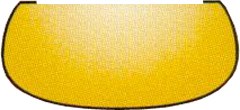
Characteristic of well-designed hulls. Good initial and final stability. Predictable and responsive when leaned or on waves.
C
Shallow “V”

Shaped with a ridge in the center, like a keel. Stable but rides deeper and is less efficient than a shallow arch. May snag on rocks.
D
Round Bottom
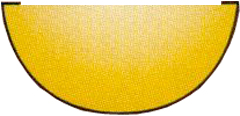
Extremely rare, used only on canoes for calm-water racing. Very fast but has no initial stability at all and is tricky to balance.
E
Flare

A flared hull widens out near the gunwales, thereby deflecting waves and resisting capsize.
F
Tumblehome
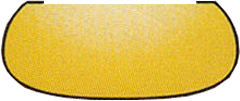
Tumblehome is the opposite of flare (Fig. 14-e). The hull curves in at the gunwales and lets the paddler paddle close to the hull. Most evident in solo designs
As mentioned, when the expert canoeists from Missoula first saw Phil Johnston’s B canoe with Boss’s squared design, they thought it would turn over when it hit the eddy seam. So did Phil. But it was so heavy that with four expert paddlers, it stayed upright. That’s when we began to think that the Lewis and Clark dugouts, fully loaded, would be about the weight of the replicas empty, and therefore quite stable by virtue of ballast weight.
Proposed Hull Design
Let’s make educated guesses about the dugout hull designs they might have chosen at Fort Mandan, after 1500 miles of boating experience ascending the currents, sandbars and eddies of the lower Missouri.
First, consider their needs, in probable order of importance:
- The biggest trees possible: we know they made at least one 33′ canoe, 36″ wide when finished, which suggests a tree about 40″ wide before debarking, with 33′ feet of straight trunk without major branches.
- The largest cargo capacity possible from that log 33′ long and 36″ wide; that is, the greatest displacement and the lightest weight.
- Given the above limitations, as efficient a hull as possible for ascending the river a thousand miles with the least “drag” on the boat.
- A hull that would not catch the current and turn over, especially when lining (which was most of the time), probably without a sling. That would mean a carefully designed, well chined and rockered bow.
Figure 15
Proposed Hull Design
36″ diameter log with canoe 36″ at widest point
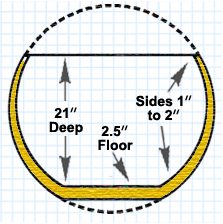
By the author.
Figure 15 shows an outline of a debarked log 36″ in diameter, and my proposal for a hull cut from that log. The grid is in 2″ squares.
They began by making four canoes but then, seeing their limited capacity, they proceeded to make two more. Finding a cottonwood 36″ in diameter and clean of major limbs for 33′ upwards, was probably not that easy, even in 1805. They chose their trees. Considering their needs, what hull design did Clark and Gass choose, to maximize carrying capacity?
The top third of the felled log, lying horizontal on the ground, is usually taken off, leaving two thirds for a canoe. Knowing they wanted to maximize volume, let’s assume they took 10″ off the top, not 12″, leaving a little higher sides and more tumblehome. Now what will yield the most cargo space out of that log 36″wide and 26″ deep? Note: We cannot know from the journals if 33″ wide refers to the outside or inside measurement, or whether that measurement was taken gunnel-to-gunnel, or lower down at the widest point of the sides.
Boss’s recommendation, on the other hand, requires a larger log, more cutting, and has less volume. To get a 36″ wide canoe, he requires a 45″ diameter trunk, clean of limbs, significantly reducing the number of adequate trees. Figure 16 compares Boss’s diagram based on a 45″ log with Bevis’s proposal, also here with a 45″ log:
Figure 16
Comparative Volumes of Rectangular and Circular Cross-Sections
A. Boss 45″ diameter log, canoe 36″ wide

Approximate number of squares inside canoe cross-section: 224
B. Bevis 45″ diameter log, canoe 36″ wide at gunnels

Approximate number of squares inside canoe cross-section: 329.
The Bevis design, from the same log, has about 50% more volume than the Boss design. Not only does Boss’s design require more cutting, and lose a lot of volume just by squaring off the log, but it will also produce a less stable hull in waves and side currents.
Of the hull cross-sections pictured in Fig. 14, the Boss hull most closely resembles the “flat bottom” hull, while mine resembles the “shallow arch” hull. The Wenonah catalogue’s illustration of stability (Fig. 17) in a flat bottom hull such as Boss’s, compared to a shallow arch hull, is particularly interesting.
Figure 17
Flat versus Arched (Rounded) Bottoms[11]Ibid.
A.
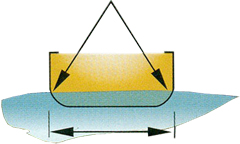
A canoe with a flat bottom hull feels steady when it’s upright on calm water. Flat bottom hulls have good initial stability.
B.
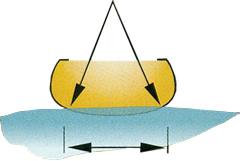
A canoe with a shallow arch hull is the widest just above the waterline. Because it oscillates slightly it doesn’t have the rock solid feeling of a flat hull.
C.
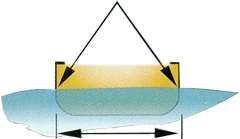
When loaded, it rides lower but has about the same shape. It will be stable as long as it is upright in calm water.
D.
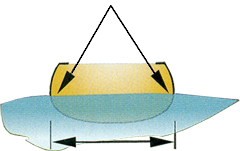
When loaded, the weight presses the widest part of the hull into the water, which makes the canoe more stable.
E.

When it leans, one side of the hull lifts entirely out of the water. With less surface area submerged, paddlers must work hard to keep it from tipping over. Flat bottom hulls have less final stability.
F.
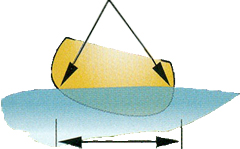
When it leans, both sides of the shallow arch hull stay in the water, making it easier for paddlers to balance.
G.

In waves that strike the canoe crosswise or at an angle, the flat bottom hull rises and falls on the surface of the waves. Paddlers must react fast to the rocking back and forth.
H.
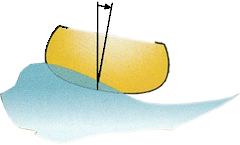
A shallow arch hull presents less resistance to waves and rocks less. Paddlers easily maintain balance.
Summation
Although my proposal leaves much more of the log intact, shaping the hull to some extent was probably necessary. As the description of the “Round Bottom” hull in Figure 15-d reminds us, canoes made of perfectly round logs have little initial stability and are “extremely rare.” This may be an exaggeration by an American canoe company marketing to a general public; in Borneo I was in several stable round logs, of heavy tropical hardwood, but the paddlers sat on their heels in the bottom of the boat, with their center of gravity low, and any cargo was also centered at the bottom of the boat. One learned quickly to balance. We will return to the issue of stability in Chapter 5.
Many of those Borneo logs had a small portion of flat bottom, and sometimes some chines (the rounded log itself produces rounded chines above a flat bottom). Lewis and Clark, in their pirogues and barge, had already negotiated 1600 miles of the lower Missouri, famous for shifting sand bars, collapsing earthen banks, and gravel shoals, unpredictable and dangerous. A round bottom boat running aground is very unstable, and also is more likely to run aground, since it sits low in the water, as does a V bottom boat. For that reason, I think they would have kept the outside contours as large as possible except for a flattening of the very bottom, as the diagram shows, making a canoe less likely to run aground, and more stable if it does.
Here are my best guesses, then, at the full length view, the hull cross-section, and the bow design of a Lewis and Clark dugout made from a log 36″ wide and 33′ long. Since we know for sure the length, width—and therefore the depth, the canoe being made of one log—this certainly gives the reader a fairly accurate view of how extraordinarily long the canoes were. I have made a slight upturn at each end, since that is some help in deflecting waves, and underneath, the canoe has some rocker for whitewater and cross-current stability. Both the upturn of the bow and stern, and the amount of rocker, could easily have been greater than I am depicting. The bow design maximizes cargo capacity by being pretty blunt, yet shaped for efficiency in ascending a large, fast river. The front of the bow seen head-on might be drawn a bit differently by every canoeist, but then, each one of their six canoes was probably different from the others, and variations in wood quality—soft spots, for instance—could change the carving and bluntness of each entry line, and the shape of the bow. They might have sacrificed a cubic foot or two of cargo space to make a finer, more efficient bow, but they mention, over and over again, too much cargo and too little freeboard. So I have followed the principle of volume first.
Notes
| ↑1 | John Reed Swanton, The Indian Tribes of North America (Washington, D.C.: Smithsonian Institution Press, 1952), 269. |
|---|---|
| ↑2 | Hiram Chittenden, History of Early Steamboat Navigation on the Missouri River, 2 vols. (Minneapolis: Ross and Haines, 1962), 91–2. |
| ↑3 | Chittenden, 91–92. |
| ↑4 | Ibid. |
| ↑5 | Roberts and Shackleton, 90. |
| ↑6 | Paul VanDerWerk, “File:Wabanaki Canoe (26106210817).jpg,” WikiCommons, commons.wikimedia.org/wiki/File:Wabanaki_Canoe_(26106210817).jpg, accessed 2 November 2024. |
| ↑7 | Roberts, 160. |
| ↑8 | Durham, 37. |
| ↑9 | Clark, 23 October 1805, in Moulton, Vol. 5:328. |
| ↑10 | Graphics and text courtesy of Wenonah Canoe, Inc. |
| ↑11 | Ibid. |
Experience the Lewis and Clark Trail
The Lewis and Clark Trail Experience—our sister site at lewisandclark.travel—connects the world to people and places on the Lewis and Clark Trail.
Discover More
- The Lewis and Clark Expedition: Day by Day by Gary E. Moulton (University of Nebraska Press, 2018). The story in prose, 14 May 1804–23 September 1806.
- The Lewis and Clark Journals: An American Epic of Discovery (abridged) by Gary E. Moulton (University of Nebraska Press, 2003). Selected journal excerpts, 14 May 1804–23 September 1806.
- The Lewis and Clark Journals. by Gary E. Moulton (University of Nebraska Press, 1983–2001). The complete story in 13 volumes.
